Garrett Nelson is famous throughout Europe as a performance artist, installation artist, and poet. His work has been lauded by art critics and showcased by some of the most prestigious galleries and museums in the world, including: Kunsthalle Basel, Kunsthalle Zürich, Arsenic Lausanne, MAMCO Genève, SALT Galata Istanbul, and Centre Culturelle Suisse Paris.
Getting to Garrett Nelson these days is no small feat. He lives in Cordoba, Argentina, in an idyllic, valley-facing house of his own design that requires navigating dirt roads and no less than three locked gates to find. He had me meet him at a nearby Shell gas station to avoid getting lost. Also, we had to run a few errands, as after our interview he was hosting a barbecue to celebrate Good Friday.
“I sent out invitations this morning and everyone is being so dramatic,” he said, eyes rolling back and wearing an old lady straw sun hat. “‘We can’t eat meat on Good Friday.’ I told them to make an exception.”
We stopped at a grocery store to stock up on raw meat and copious amounts of alcohol. He breezed around the market, placing things into his cart, and going over the guest list with me. “She’s amazing, 70 and stylish and her family used to own half of the province.” Garrett speaks with a soothing almost aloof affect that makes the outlandishness of some of his statements all the more entertaining.
I didn’t realize it at first, but he admitted he was a bit shaken up, as his dog Walter had been attacked by two rottweilers two nights prior and he had been back and forth to the veterinarian. “Narco assholes,” he said of the dog’s owners, who live nearby in an ornate compound with grecian statues and fountains that would make Liberace blush. “I’m getting those dogs kicked out of the neighborhood.”
“How long have you had Walter?” I asked.
“Oh,” he said, placing a seventh bottle of champagne into his cart. “I think five years? I found him starving at a gas station outside Villa Maria. He was so sweet and emaciated. He followed me to my hotel and I said to him, ‘If you want me to take you with me, meet me out here tomorrow.’ The next morning he was waiting by my car.”
These sorts of stories, wrapped in drama and romance, pour out of Garrett nonstop. “I was kidnapped in Colombia,” he told me. “I was in an artist residency and the guy running it forced everyone to hike this extremely dangerous trail up in the mountains. Three men with guns, sabers, and machetes came out of the jungle and stripped us of everything we had and held us for a day and half. We escaped through the jungle. We ran for 14 hours-straight, no shoes, no water. I blame Swiss cultural funding!”
This last remark makes more sense when you find out that Swiss cultural endowments paid for the residency and also refused to evacuate him after – but all his stories finish in a simple assured end-statement, most commonly: “I’d never do it again.” For example: “Yes, I toured with a traveling circus for two years. I’d never do it again.” “Next thing I knew I was completely naked drinking absinthe with the mayor’s daughter. I’d never do it again.”
“I’d never do it again.”
Zurich, Mexico City, Berlin, New York, Palermo… he’d never do any of them again, either.
When we finally made it to his house, he lent me a large black cowboy hat to protect me from the intense Cordoba sun and set us up by his pool.
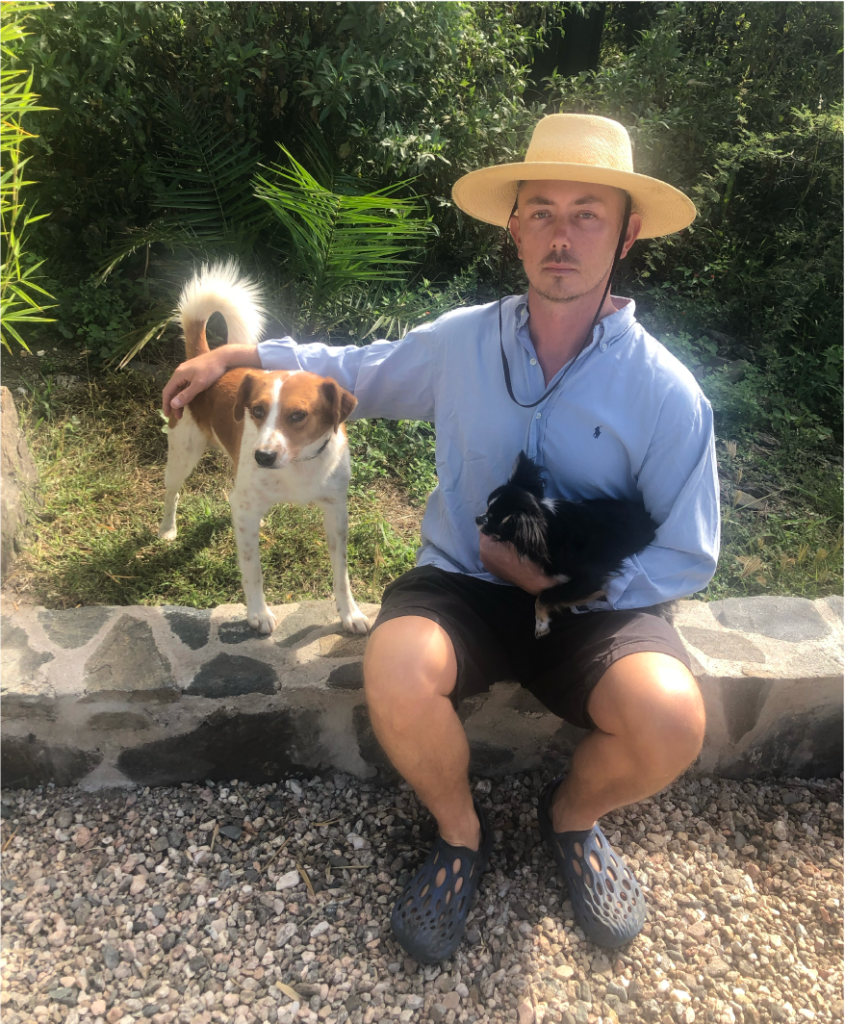
As Garrett describes it, his origins in performance were “unintentional.”
“It came from a zeitgeist,” he said. “Where performance was something people wanted to give space and time and [money] to in Europe. Especially in Switzerland, [where I was living]. I came into performance out of… it’s weird to call it a market driven decision, but [it’s just where my talents and demand intersected]. Every single opening, every single curator wanted a performance.”
His performances are subtle and poignant, in contrast to the shocking and body-centered performance art that was and is still very in vogue in fine art circles.
“In all of my performances,” he said, proudly. “I have a champagne break. There’s a generosity to it. The performance could be very serious, and then cut it in the middle and say, ‘Now, we’re all going to have a drink together and then we’ll start again.’ When you’re performing, you’re asking for so much attention from people and they [don’t necessarily know who you are]. It works well. It can change people’s mood and engagement level quickly. There’s a lot of [audience abuse] in performance art. And it’s like, can’t we be nice? Let’s treat ourselves.”
“In all of my performances, I have a champagne break. There’s a generosity to it.”
“There’s a generally regarded strong dichotomy between cabaret and fine performance art,” I said. “But you have done both, can you speak about your time in the circus?”
“I joined the cabaret simply out of research. I wanted to research dadaism. It’s not great work. But, it’s generous and deeply unpretentious, which is something to celebrate.”
He then paused, and his face winced in pain, as if recalling a vast and devastating trauma. “God,” he said. “I hate jugglers.”
“Are there any advantages to a cabaret style performance compared to a fine art context?” I asked.
“The white cube gallery is different from the traditional black box theater,” he said. “You don’t have the same amount of tricks and smoke and mirrors at your disposal.”
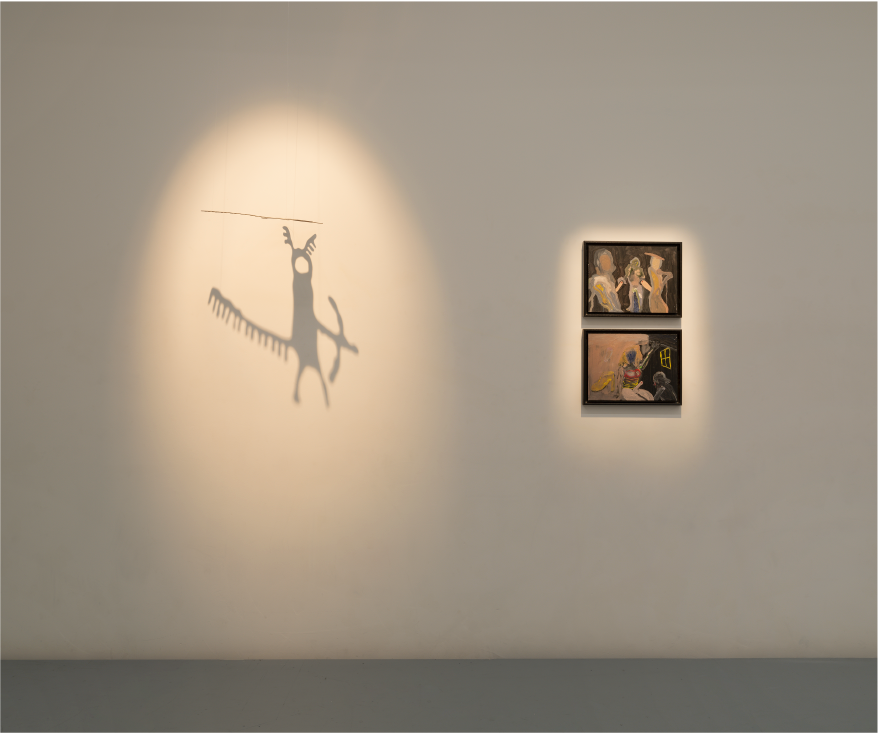
“I understand that collaboration is a big part of your work,” I said. “What draws you to it as a form of creation?”
“When I started,” he said, “I loved that when you collaborate with someone, you create a language with somebody and keep it at a high level. You don’t have to take sole responsibility for any of the ideas. You egg each other on. Now when I collaborate, it’s more about celebrating other people’s stories and giving space to those stories. It’s about me sharing context. When I worked with Richie Shazam on Blind Audition– obviously they have huge context as a model and Instagram star– but isn’t often asked about identity or [their lived experience].”
“You also did a written biographical piece with a Warhol star, right?” I asked.
“I worked with Viva, who was a Warhol superstar, and [she’s only ever been asked about that time]. I wanted to find her other stories, and I ended up centering the writings on her affair with William Eggleston. He was the most famous photographer in the world and the love of her life. She ended up getting an abortion in the 70s. It was all very traumatizing- she wanted to have the baby but was pressured not to. It wasn’t part of the popular narrative about Andy Warhol and The Factory and everything. It’s about finding the subversive and human core of performative people.”
Walter came up to Garrett, still distressed from the attack, and put his head in his lap. He had stitches above his right eye and on his lip, with the puncture above his eye having damaged the eyeball.
“If you go blind, Walter,” he said. “I’m going to get those narco assholes.” The image of Garrett, taking on a fleet of gangsters, Scarface-style, fluttered across my mind. It was at first comical, but soon I became a bit concerned, as I wouldn’t necessarily put it past him.
“There is a fine line,” I said. “Between ‘elevating’ and exploiting people. How do you manage that?”
“Real relationships with people,” he said. “These are one on ones. These are collaborations. It is a choice to be together. They are friends first of all. The relationship is built long before you ever work together. Also, basic economic fairness. Fairly being compensated, fairly being credited.
“Is there an aspect to collaboration where you can hide more?” I asked.
“Yea,” he said. “I think with Blind Audition, I was just fed up being the center of attention with performative work. I was a little bored with performative work. I wanted to be less visible. I made giant curtains and hid behind them.”
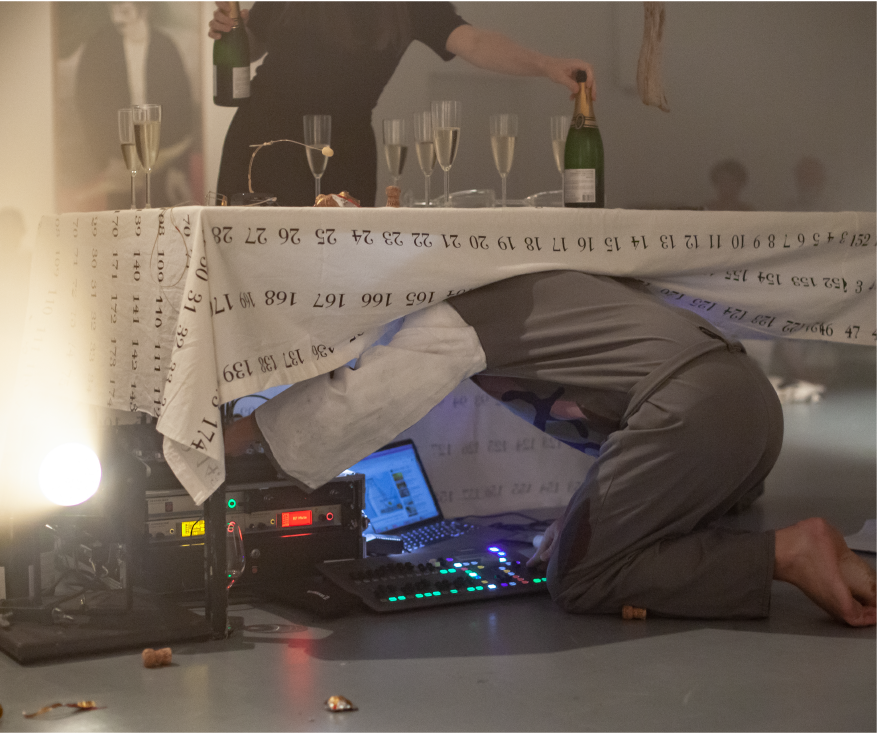
“You also use a lot of nudity in your work,” I said. “Why is that?”
“Nudity and performance are joined so often. Nudity just seems to me the most immediate way to be present in a space. It differentiates the performers from the public. It creates vulnerability and instant respect that you’ve overcome shame. It’s highly unsexual, just banal nudity.”
“Another consistent element to your work is poetry,” I said. “Was that a first love, or more a device for performance?”
“I consider myself primarily a poet,” he said. “But I write to read, I don’t write to publish. Voice is critical. It’s so temporary and fragile. Voice is full of clues to who is telling their story. Voice is far more vulnerable than the nude body. [It’s worked to my advantage]. In Switzerland my voice was given a lot of space. People loved hearing my voice, I don’t know why.”
“I write to read, I don’t write to publish. Voice is critical. It’s so temporary and fragile.”
“I’ve read that you don’t like recordings of your performances being made,” I said. “Is this to maintain that fragility and temporality?”
“It’s about experiencing things in a specific time and place,” he said. “There are recordings of the performances, [but they aren’t the art themselves].”
Hearing Garrett’s endless stories of big cities and lavish parties, I had to see a stark contrast to his beautiful and secluded home in the mountains. I wondered if he felt exhausted by the life he had led or if he had just moved on to a more meditative chapter. “Are you just focused on chasing beauty and calm right now?” I asked.
“The artists in history I admire the most are the ones who just lived their lives while making art at the same time. The wives of famous curators. Making work, but often their work was about their kids or their lives. There’s a word in German, ‘lebenskünstler,’ which means ‘life artist.’ It’s often given to rich housewives, but I love it. It’s the champagne break.”
“But also, you’re really out here in the middle of nowhere, and so particular about the shows you’ll participate in,” I said. “Are you a bit fed up with the art world?”
“When I go back to Europe to do shows, they’re great, but the context is so hard. Even though it sounds luxurious. Staying at these beautiful villas, gorgeous gardens, Rome, Zurich, assistants putting up your show. But it’s so impersonal. It feels like you’re eating in a school mess hall. There’s a darkness to it. All of Art Basel is just a stock market. Those works come out of the basement once a year to change hands. With that reality and posture-y art writing. It’s just devoid of humanity. It does make me a bit jaded. In some ways I have respect for corporate America, it’s direct and honest.”
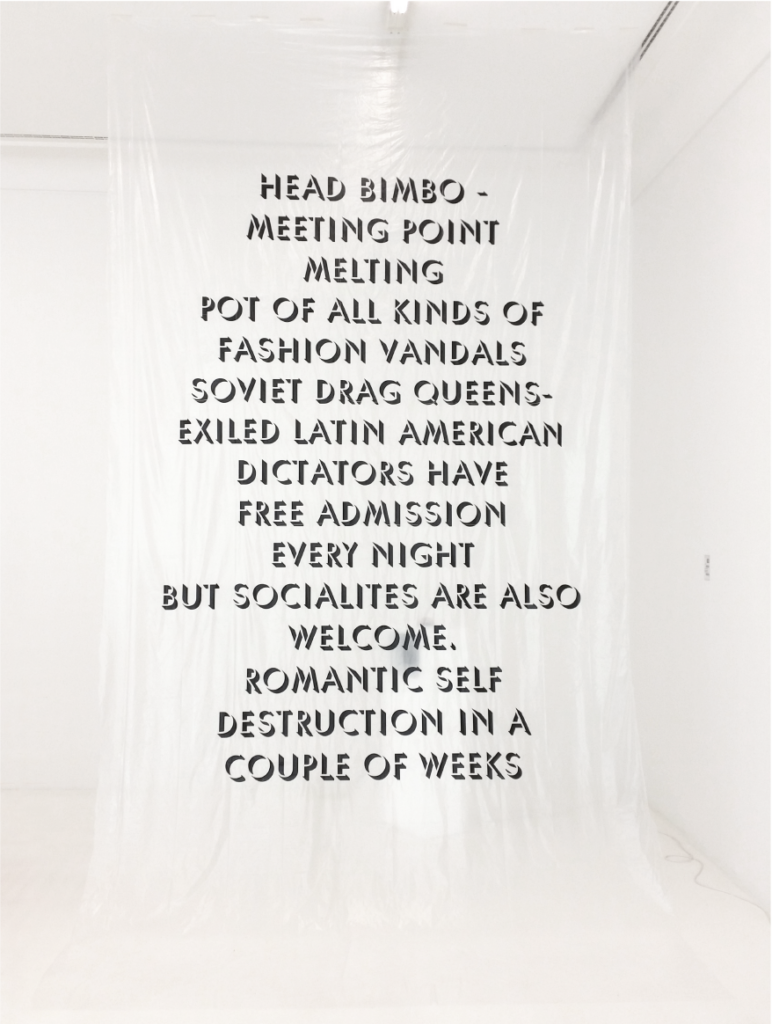
“Do you think your experience getting kidnapped in Colombia has something to do with this?” I asked.
“Yes,” he said. “That was the final straw. But most residencies are alienating and exploitative. Who thinks these are good for artists? The government? Colombia wasn’t the only bad one. Once I was in Sri Lanka at a residency that was in a compound with armed guards and an electric fence. There was a huge drought happening and the elephants that lived in the jungle surrounding us would try and get into the compound at night to steal water from our pool. As soon as they’d touch the fence they’d get electrocuted and scream out in pain and then try again and again, their shrieks filling the night. I got a bottle of diazepam from the pharmacy and slept through the whole residency. I’d never do it again.”
“Wow,” I said, chuckling, but profoundly disturbed by the story. “Is another part of this retreat inward because you can’t think of anything new to do?”
“I don’t want to be jaded or bitter,” he said. “It’s a phase where I’m investing in the next half of my life. I want to have a beautiful home space. I just have to take the time to do that, and once that’s done I can do other things. I’ve taken the pressure off. I felt so much pressure as a young artist to be in the right shows and know the right people. I did it and it’s still there and the body of work is still there and my knowledge of what I accomplished is still there. I can do my work anywhere and I can show it or not. I don’t want to work when I’m dead. And I don’t give a shit about what happens to my work when I’m dead. That’s not why I’m doing it. A lot of artists think about their archive. It’s sad and dark.”
We had lost track of time, and guests began calling him with advice on traversing the gravel enigma and gates to find the house. As he answered their questions he led us inside and poured us two glasses of champagne. “A champagne break,” he said.
We sat on his back porch sipping the bubbly and building the fire for his grill. Guests began arriving and soon the house was filled with laughter and chatter in multiple languages. A 23-year-old model from New York bantered with the 70-year-old Cordoba ex-socialite. An American playwright swapped stories with a banker from Buenos Aires, visiting for the weekend. We toasted and drank and ate a lot of meat to celebrate Good Friday. And then, a massive rain cloud swept the mountain, sizzling the coals in the grill and pooling in the dirt roads.
“There’s probably a rainbow,” Garrett said casually, as the storm moved out and down into the valley.
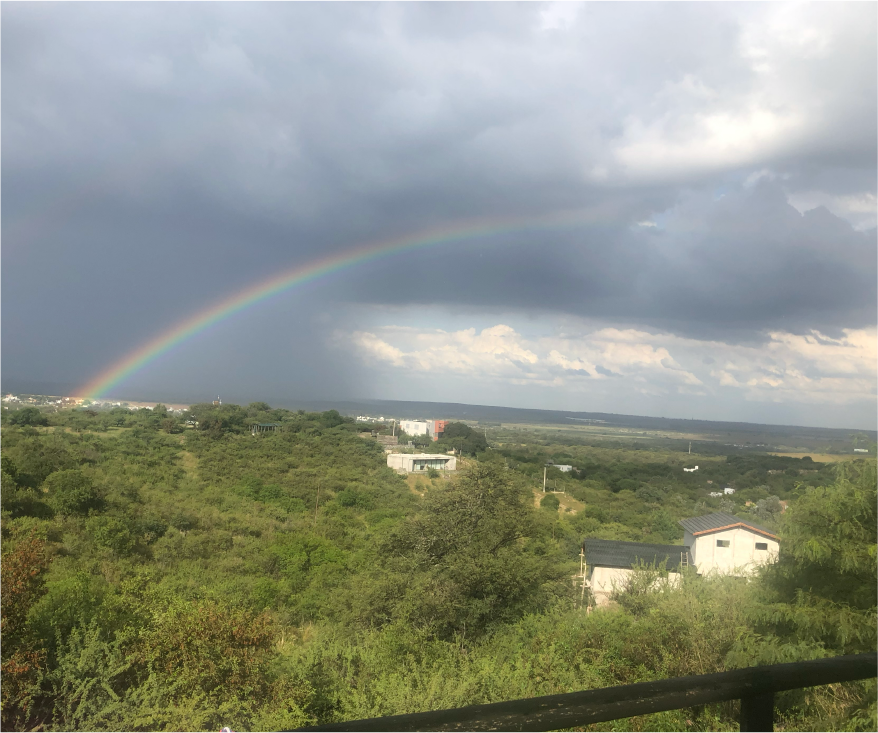
We ran around to the front of the house that faced down into the valley. There, stretching out, through the gray storm and into the lush greenery, was the most vibrant rainbow I have ever seen. Trauma and existential dread and jugglers aside, who wouldn’t take this view over the sound of crying elephants?



